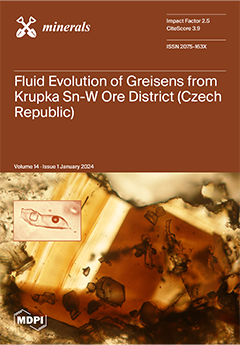Permian intermediate–felsic igneous rocks, widely distributed in the southern Beishan orogen, provide crucial constraints on the geodynamic process of the late Paleozoic Paleo-Asian Ocean. New zircon U–Pb dating using LA–ICP–MS determines the age of the northern Qingshan diorites, the Heishantou quartz diorites, and
[...] Read more.
Permian intermediate–felsic igneous rocks, widely distributed in the southern Beishan orogen, provide crucial constraints on the geodynamic process of the late Paleozoic Paleo-Asian Ocean. New zircon U–Pb dating using LA–ICP–MS determines the age of the northern Qingshan diorites, the Heishantou quartz diorites, and the southern Qingshan biotite granodiorites at 300 Ma, 294 Ma, and 291–286 Ma, respectively. Their whole-rock compositions exhibit arc-like geochemical features. Moreover, their zircon trace elements show the characteristics of continental arc zircons. The diorites, characterized by low SiO
2, high MgO with Mg# (50–52), and low Cr, Co, and Ni, display enrichment in Sr-Nd-Hf isotopes (
87Sr/
86Sr = 0.7060 to 0.7061; ℇ
Nd(t) = −1.4 to −1.7; ℇ
Hf(t) = −4.7 to −0.6), originating from the fractionation process of magma derived from the enriched mantle. The quartz diorites show moderate SiO
2 and variable MgO (2.75–3.84 wt%) and exhibit enrichment in Sr-Nd (
87Sr/
86Sr = 0.7048–0.7050; ℇ
Nd(t) = −1.5–+0.9) and depletion in zircon Hf isotopes (ℇ
Hf(t) = 3.8 to 7.8). Combined with their high Y (20.0–21.0 ppm) and low (La/Yb)
N (6.0 to 17.2), we conclude that they originated from the juvenile lower crust previously influenced by oceanic sediments, with the input of enriched mantle-derived materials. The biotite granodiorites display low A/CNK (0.91–0.97), 10000*Ga/Al (1.8–1.9), and Ti-in-zircon temperatures (average 711 °C), indicating that they are I-type granitoids. These rocks show enrichment in Sr-Nd isotopes (
87Sr/
86Sr = 0.7054 to 0.7061; ℇ
Nd(t) = −2.0 to −1.6) and many variable zircon Hf isotopes (ℇ
Hf(t) = −2.3 to +4.5). Geochemical studies indicate that they originate from the mixing of magmas derived from the enriched mantle and preexisting juvenile lower crust. All these data imply the existence of oceanic subduction in southern Beishan during the early Permian. Integrating these results with previous studies, it is inferred that the retreating subduction of the Liuyuan Ocean contributed to early Permian intermediate–felsic rocks becoming widespread in the Shibanshan unit, the southernmost part of the Beishan orogen, and also why the Paleo-Asian Ocean in southern Beishan did not close during the early Permian.
Full article





